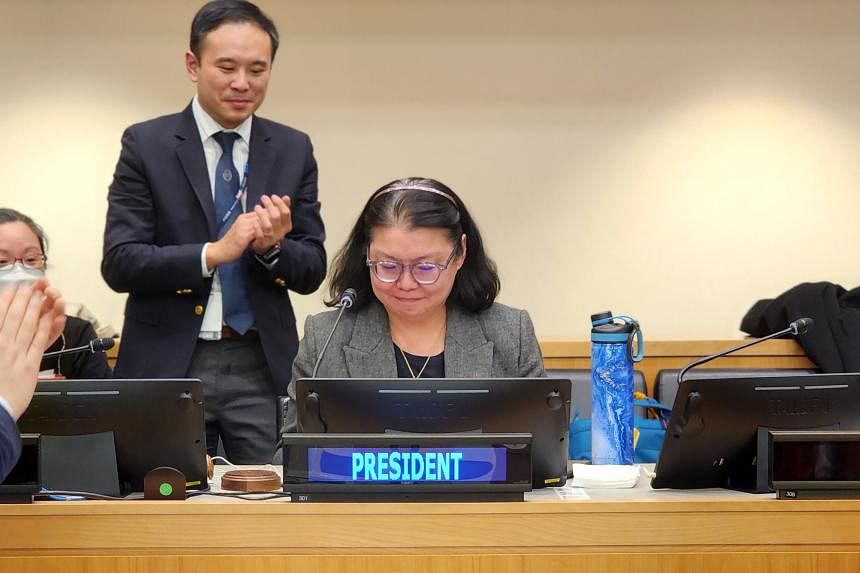UNITED NATIONS - After years of talks, United Nations’ member states finally agreed to a text on the first international treaty to protect the high seas, a fragile and vital treasure that covers nearly half the planet.
“The ship has reached the shore,” conference chair Rena Lee announced at the UN headquarters in New York shortly before 9.30pm on Saturday local time, to applause from delegates.
Mrs Lee is Singapore’s Ambassador for Oceans and Law of the Sea Issues and Special Envoy of the Minister for Foreign Affairs.
After more than 15 years of discussions, including four years of formal talks, the third so-called final negotiating session in less than a year heralded the long-awaited consensus.
The treaty is seen as essential to conserving 30 per cent of the world’s land and ocean by 2030, as agreed by world governments in a historic accord signed in Montreal in December.
Following two weeks of intense talks at the UN headquarters in New York, including a marathon overnight session Friday into Saturday, delegates finalised a text that cannot be significantly altered.
“There will be no reopening or discussions of substance,” Mrs Lee told negotiators.
The agreement will be formally adopted at a later date once it has been vetted by lawyers and translated into the United Nations’ six official languages, she announced.
In a statement on Sunday, Singapore’s Ministry of Foreign Affairs (MFA) said it welcomed the “successful and timely conclusion” of the Biodiversity Beyond National Jurisdiction (BBNJ) Agreement, which came just after the 40th anniversary of the adoption of the United Nations Convention on the Law of the Sea (Unclos) treaty in 1982.
“The success of the BBNJ Intergovernmental Conference process reaffirms the importance and relevance of Unclos and multilateral cooperation, and the United Nations in establishing and upholding a rules-based international order,” the MFA spokesman said.
The spokesman added that Mrs Lee’s leadership “enabled parties to bridge differences and arrive at an ambitious and future-proof BBNJ Agreement”.
The high seas begin at the border of countries’ exclusive economic zones, which extend up to 370km from coastlines. They thus fall under the jurisdiction of no country.
Even though the high seas comprise more than 60 per cent of the world’s oceans and nearly half the planet’s surface, they have long drawn far less attention than coastal waters and a few iconic species.
Ocean ecosystems create half the oxygen humans breathe and limit global warming by absorbing much of the carbon dioxide emitted by human activities.
But they are threatened by climate change, pollution and overfishing.
Only about one per cent of the high seas are currently protected.
When the new treaty comes into force after being formally adopted, signed and ratified by enough countries, it will allow the creation of marine protected areas in these international waters.
The treaty on the “conservation and sustainable use of marine biodiversity in areas beyond national jurisdiction” also obliges countries to conduct environmental impact assessments of proposed activities on the high seas.
A highly sensitive chapter on the sharing of potential benefits of newly discovered marine resources was one of the focal points of tensions before it was finally overcome as the scheduled talks, due to end Friday, overran by a day.
Developing countries, without the means to afford costly research, had fought not to be excluded from the expected windfall from the commercialisation of potential substances discovered in the international waters.
Eventual profits are likely from the pharmaceutical, chemical or cosmetic use of newly discovered marine substances that belong to no one.
As in other international forums, notably climate negotiations, the debate ended up being a question of ensuring equity between the poorer global South and richer North, observers noted.

In a move seen as an attempt to build trust between rich and poor countries, the European Union pledged €40 million (S$57.3 million) in New York to facilitate the ratification of the treaty and its early implementation.
The EU also announced US$860 million for research, monitoring and conservation of oceans in 2023 at the Our Ocean conference in Panama that ended on Friday.
Panama said a total of US$19 billion, including a US$6 billion commitment from the United States, was pledged at the conference to protect seas.
In 2017, the UN General Assembly adopted a resolution calling on nations to establish a high seas treaty.
It originally planned four negotiating sessions, but had to pass two resolutions to ensure two additional sessions. AFP


